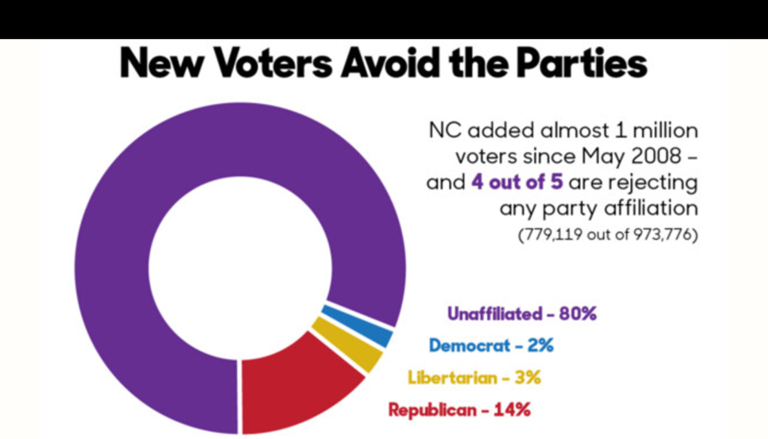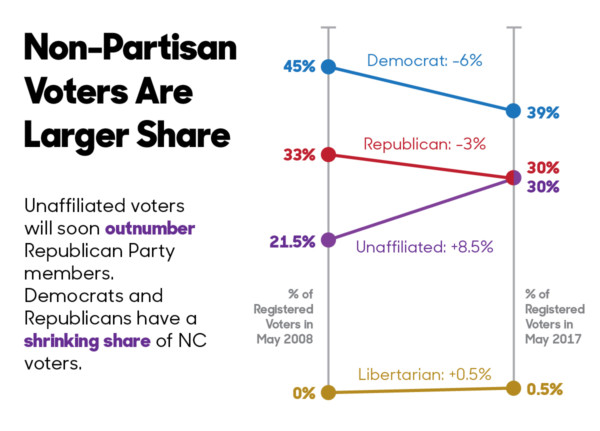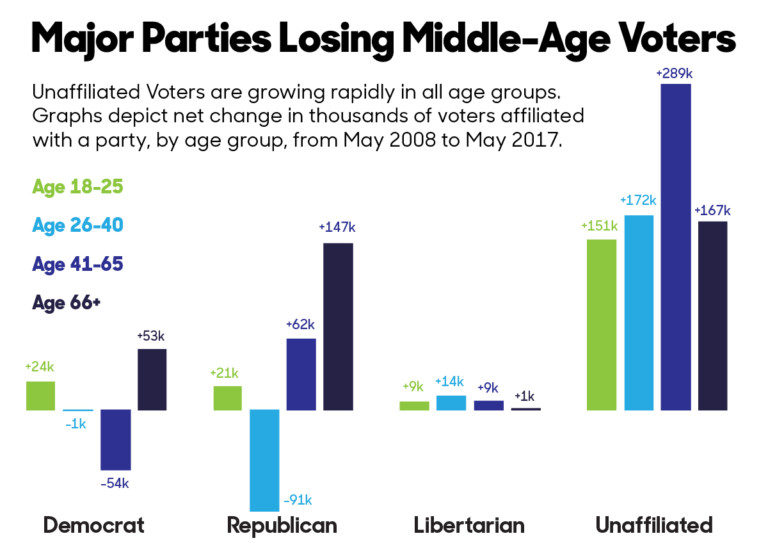New Voters Reject Party Labels; Democrats, GOP Growing Older
North Carolina has added nearly one million voters to the registration rolls since Barack Obama’s first victory in the state in May 2008 – and a surprising four out of five of them (80%) are refusing to choose a party label, according to an analysis by the voting rights group Democracy North Carolina.
“Ironically, while the General Assembly is busy passing laws to add party labels to more statewide and local elections, new voters are rejecting the major parties at a record rate,” said Bob Hall of Democracy North Carolina. (The 80% not selecting a party beats the 65% of new voters from 2000 to May 2008 who were unaffiliated.)

He also pointed out that today’s 2.02 million unaffiliated or independent voters are relatively young. About half of them are under age 41, while only a third of the 2.64 million Democrats and 30% of the 2.05 million Republicans are under 41.
“The rapid growth of independent voters will have a lasting impact on Tar Heel politics,” said Hall. “North Carolina will continue being a swing state in presidential elections, with a notable bias for candidates outside the mainstream.”
“Studies show that independent voters across the ideological spectrum want ethical politicians who keep their promises and focus less on partisan maneuvering than on solving problems for their communities,” he added. North Carolina polls show that unaffiliated voters strongly support redistricting reform and protecting the court system from special-interest influence. “But as the word ‘unaffiliated’ suggests, these voters are less attentive attentive to election campaigns or policy debates, so their potential influence remains unrealized,” he said. In 2016, only 63% of unaffiliated voters cast ballots, compared to 75% of registered Republicans and 68.5% of Democrats.

Hall said he expects that unaffiliated voters will outnumber Republicans by the end of this year, and they will continue to reduce the Democrats once-dominant share of NC registered voters, which is now down to 39%, a drop from 45% in 2008 and 50% in 2000.
He pointed out that unaffiliated voters already outnumber Democrats and Republicans in both the 18- 25 and 25-40 age groups.
“Legislators and candidates from the major parties need to adjust their messages and behavior if they want to attract new supporters and keep up with independent voters,” he said.
After Barack Obama won the May 6, 2008, Democratic primary, the Democratic Party saw its membership swell. It climbed from 2,615,500 on the eve of that primary to a peak of 2,878,200 right after the November 2012 presidential election, a 10% increase. But with people moving in and out of the state, dying, or changing party affiliations, the Democratic Party is back to 2,638,200 members as of May 6, 2017, for a net gain over nine years of less than 1%.
Data from the State Board of Elections show the Republican Party hit a record high of 2,099,600 members at the end of 2016, after the surge of support for Donald Trump. But that number has now declined to 2,048,700 after the normal post-election removal from the registration rolls of voters who have moved or otherwise become disqualified.
In the nine years from May 2008 to May 2017, Republican membership increased by 7% while the number of unaffiliated voters grew by 63%. The major growth for Republicans is among senior citizens. Because of moves, aging, and registration changes, the GOP has 90,600 fewer members in the 26-40 age group, but gained 147,500 in the 66 and up group.
Meanwhile, the Democratic Party has suffered net losses in the 26-40 and 41-65 age groups, and it picked up only 53,300 new members among the 66 and older Boomers. Since May 2008, the number of unaffiliated voters has grown by more than 150,000 voters in each of the four age groups – something no partisan or racial group has managed to do, despite the state’s steady population increase.
Libertarians, who did not qualify as a party in 2008, now have 32,500 members or less than one half a percent of the state’s 6,742,200 voters.

The 973,800 net new voters added since May 2008 include 139,700 Republicans (14% of the new voters); 22,800 Democrats (2%); 32,500 Libertarians (3%); and 779,100 unaffiliated voters (80%). As of May 6, 2017, the state’s 6,742,200 registered voters include 2,048,700 Republicans (30.4% of total); 2,638,200 Democrats (39.1%); 32,500 Libertarians (0.48%); and 2,022,800 unaffiliated voters (30.0%).
